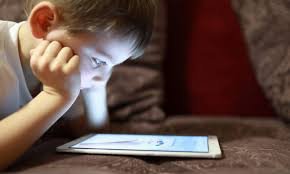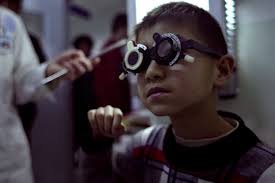Child myopia cases have skyrocketed in recent years, with a staggering 50% increase in nearsightedness among African children under the age of 16. Medical experts are warning of a potential epidemic. In an in-depth investigation, Africa Health Report’s Korede Abdullah uncovers the shocking trajectory of child myopia, which is rapidly becoming a major public health concern across the continent, threatening the vision and well-being of millions of African children.
An alarming trend is emerging in the realm of public health, as child myopia, or near-sightedness, continues to skyrocket among younger generations in Africa. The disease has reached alarming proportions globally, with a staggering increase in cases among children and adolescents over the past decade.
Africa Now Facing a Surge
Africa, once considered a low-risk region for myopia, is now facing a startling surge in childhood near sightedness, with prevalence rates doubling since 2010 across all age groups, sexes, and settings. This alarming trend is projected to triple by 2050, posing a significant public health threat to the continent.

Compounded by limited access to ophthalmic services and inadequate spectacle coverage, this rising epidemic puts millions of African children at risk of vision impairment, underscoring the urgent need for increased awareness, improved eye care infrastructure, and targeted interventions to address this growing health concern.
This escalating issue has significant implications for the overall well-being of children and the healthcare system at large.
The WHO Prediction
By 2050, the World Health Organization forecasts that half of the global population will be nearsighted, with a staggering one-fifth facing increased risk of blindness due to severe myopia complications, if current trends persist.
In response, clinicians and researchers at Casey are proactively investigating various solutions to halt and reverse this alarming trend, seeking innovative ways to prevent and slow the progression of myopia, and ultimately protect the vision and well-being of future generations.
Public Health Concern

Child myopia, or nearsightedness, is a growing public health concern where children’s eyes progressively lose ability to focus on distant objects. If left untreated, it can lead to severe complications, including blindness, retinal detachment, and glaucoma.
According to medical experts, child myopia’s implications extend beyond vision, affecting academic performance, social development, and quality of life, with potential long-term consequences on mental and physical health, education, and economic productivity.
Urbanization and Sedentary Lifestyles Fuel Child Myopia Epidemic
A alarming rise in child myopia cases has been linked to urbanization and sedentary lifestyles, according to recent studies. Children spending excessive time indoors, glued to screens and engaging in near-work activities, are increasingly prone to developing near sightedness.
Lack of outdoor play and natural light exposure exacerbates the risk, with urban kids twice as likely to develop myopia as their rural counterparts. Experts urge parents to balance screen time with outdoor activities and encourage regular eye exams to combat this growing health concern.
Screen Time Epidemic: Excessive Digital Use Linked to Child Myopia Surge
A staggering increase in child myopia cases has been linked to excessive screen time, with digital devices, TVs, and computers contributing to the alarming trend. Studies reveal that children spending over 2 hours daily on screens are 50% more likely to develop nearsightedness.
Prolonged near-work activity strains young eyes, leading to irreversible vision damage. Medical experts warn parents to limit screen time, encourage outdoor play, and ensure regular eye exams to protect their children’s vision and prevent long-term consequences.
Genetic Predisposition Found to Play Significant Role in Child Myopia
Researchers have identified genetic predisposition as a major contributor to the growing child myopia epidemic. Studies reveal that children with one or both parents suffering from myopia are significantly more likely to develop near sightedness.
Specifically, kids with two myopic parents face a 3-4 times higher risk. While lifestyle factors like screen time and lack of outdoor play exacerbate the issue, genetic makeup is now recognized as a key factor. Early eye exams and monitoring are crucial for children with family history of myopia to prevent severe vision impairment.
Societal Pressures and Environmental Factors Drive Child Myopia Spike
Child myopia cases are soaring due to societal and environmental influences, experts warn. Urbanization, academic pressure, and cultural emphasis on education have led to increased screen time and decreased outdoor play.
Poor lighting in homes and schools, inadequate physical activity, and pollution also contribute to the epidemic. Additionally, the valorization of academic achievement over physical activity has resulted in children spending more time indoors, further increasing their risk.
A Lagos-based ophthalmologist who preferred to remain anonymous because he was not permitted to speak with the press in a public facility where he works without authorization, told Africa Health Report that he would urge the policymakers and parents to prioritize eye health and balance academic rigour with outdoor activities to protect children’s vision.
According to the ophthalmologist, “To combat the growing epidemic of child myopia, I strongly advise policymakers and parents to prioritize eye health. We need to strike a balance between academic rigor and outdoor activities.
“Encouraging children to spend more time outdoors, engaging in physical activities, and reducing excessive screen time can significantly reduce the risk of developing myopia.
“Additionally, regular eye exams and monitoring can help detect vision problems early on. It’s crucial we take proactive steps to protect our children’s vision and ensure their long-term eye health.”
Long-Term Vision Impairment and Blindness
Untreated child myopia can have catastrophic consequences, leading to long-term vision impairment and even blindness.
If left unaddressed, myopia can progress to severe levels, increasing the risk of retinal detachment, glaucoma, and cataracts.
Studies warn that children with severe myopia face a five-fold increased risk of blindness by adulthood.
Experts emphasize the urgent need for early detection, treatment, and prevention strategies to safeguard children’s vision, warning that irreversible damage can occur if intervention is delayed. Prompt action is said to be crucial to prevent a lifetime of vision loss.
A Hidden Toll on Academic and Social Struggles
Beyond vision loss, child myopia takes a significant toll on academic performance and social development. Studies reveal that myopic children often struggle with reading, writing, and overall academic achievement, leading to decreased self-esteem and confidence.
Social interactions also suffer, as children with untreated myopia may avoid activities, sports, and social events due to vision difficulties, exacerbating feelings of isolation and anxiety.
Experts stress the importance of early intervention to prevent long-term consequences on children’s educational and emotional well-being.
Economic Toll on Families and Healthcare Systems
Child myopia imposes a significant economic burden on families and healthcare systems worldwide. According to the ophthalmologist, treatment and correction costs, including glasses, contacts, and surgeries, can exceed =N=15,000,000 (Fifteen Million Naira) per child over a lifetime.
Mrs. Folake Akinsola, a Lagos-based federal government civil servant and single mother, shared her financial struggles with this newspaper, revealing the hefty price tag of caring for her 9-year-old child’s myopia.
“The constant eye exams, glasses, and treatments have become a significant financial burden,” she said.
Mrs Akinsola added, “I spend a substantial amount regularly to manage my child’s condition, straining my resources and impacting our quality of life.”
Additionally, lost productivity and opportunity costs associated with vision-related absences and reduced academic achievement can total billions annually.
Healthcare systems also face increased demands on resources, with projected treatment costs for child myopia expected to triple by 2050, underscoring the urgent need for preventive measures and early interventions.
Child Myopia Linked to Broader Health Concerns
Researchers warn that child myopia may be a harbinger of other health issues, with studies suggesting a potential link to obesity, mental health concerns, and decreased physical activity.
Children with myopia are more likely to lead sedentary lifestyles, increasing their risk of obesity and associated conditions. Additionally, the social isolation and decreased self-esteem stemming from vision problems may contribute to anxiety and depression.
Experts urge holistic approaches to address child myopia, considering its far-reaching implications for overall health and well-being.
The National Eye Health Strategic Development Plan (2024-2028)
The Nigerian government marked World Sight Day 2023 by launching crucial documents to enhance eye health in the country. At an event attended by representatives of President Bola Tinubu and First Lady Oluremi Tinubu, senior officials, development partners, and medical professionals, the Federal Ministry of Health and Social Welfare unveiled three strategic documents.
The strategy focuses on ‘universal eye care services towards universal health coverage’ for Nigeria. The strategy is to implement inclusive, integrated, patient-centred eye services that meet the needs and aspirations of Nigerians, striking the balance between promotive, preventive, curative and rehabilitative services.
Education Key to Combating Child Myopia Epidemic
In response to the alarming rise in child myopia, educational programs and awareness initiatives are being hailed as crucial interventions. According to Oteri Okolo, the National Eye-care Coordinator, Ministry of Health, governments, health organizations, and schools are launching campaigns to inform parents and children about myopia risks, prevention strategies, and treatment options.
She expressed optimism that programs promoting outdoor activities, reduced screen time, and regular eye exams are showing promise.
“The Nigerian government has put in place initiatives like ‘Eye Health Education’ and ‘Myopia Awareness Month’ aim to empower families with knowledge, encouraging healthy habits and early detection to curb the child myopia epidemic and protect vision for generations to come.”, Dr Okolo added.
FG, Lagos Unveil Eye Care Centre in Lagos State
In July the Federal Ministry of Health and Social Welfare, in partnership with the Lagos State Ministry of Health and Onesight Essilorluxottica Foundation, launched a state-of-the-art eye care centre at Alimosho General Hospital in Igando, Lagos.
The facility, dubbed the First Vision Centre, aimed to increase public access to quality eye care services. The launch coincided with the rollout of the “Effective Spectacle Coverage Initiative Nigeria Jigi Bola 2.0,” a comprehensive program designed to expand spectacle coverage and address vision impairments across the state.
The collaborative effort was billed to bridge the gap in eye care services and improve the overall vision health of Nigerians.
Speaking during the event, the National Coordinator of the National Eye Health Programme, Dr Oteri Okolo, said the initiative which was created by President Bola Tinubu is in line with the World Health Assembly’s global target for effective coverage of eye care by countries by 2030.
Okolo said, “Eye care is very important and good vision is very critical to humans, and that is why this initiative of President Tinubu is to ensure that Nigerians have access to affordable glasses.”
Also speaking, the President of Onesight Essilorluxottica Foundation, Mr Anurag Hans, noted that the organisation was committed to solving the problem of various eye impairments globally.
He disclosed that the foundation had initiated programmes to eliminate poor vision challenges in 120 countries and had also distributed 18 million glasses to people around the world.
While speaking during the event, the National Coordinator of the National Eye Health Programme, Dr Oteri Okolo, said the initiative which was put in place by President Bola Tinubu is in line with the World Health Assembly’s global target for effective coverage of eye care by countries by 2030.
Okolo said, “Eye care is very important and good vision is very critical to humans, and that is why this initiative of President Tinubu is to ensure that Nigerians have access to affordable glasses.”
While making his remarks, Hans, noted that the organisation was committed to solving the problem of various eye impairments globally.
Hans said that the Onesight Essilorluxottica Foundation has launched global initiatives to eradicate poor vision challenges, benefiting 120 countries through comprehensive programs. He added that to date, the foundation has distributed an impressive 18 million glasses worldwide, significantly improving vision health and transforming lives.
A Staggering Number of Victims
In Nigeria, a staggering 24 million people lived with vision loss and 1.3 million were blind as of 2020, while an additional 50 million required basic eye care services for non-vision impairing conditions.
To address this, the National Eye Health Programme launched three critical documents: The National Eye Health Strategic Development Plan (2024-2028), focusing on inclusive and integrated eye services. The Diabetic Retinopathy Screening and Management Guidelines, and The Nigeria Glaucoma Guidelines and Toolkit.
These initiatives aim to enhance Nigeria’s eye health landscape, providing comprehensive care and promoting universal health coverage.
According to experts, by implementing these strategies, Nigeria takes a significant step towards mitigating vision loss and ensuring better eye health for its citizens, especially the young people which constitutes the back bone of the country’s labour force.
According to an article jointly written by Ben Aghaji, Senior Lecturer, College of Medicine, University of Nigeria, Enugu Campus and Clare Gilbert Professor of International Eye Health: International Centre for Eye Health, London School of Hygiene and Tropical Medicine, London, UK, and published in Community Eye Health Journal, the scholars said in low- and/or middle-income countries, nine out of ten people who are blind or visually impaired have a condition that could have been prevented or treated.
This suggests that preventive measures and eye health promotion could play an important role in reducing blindness and vision impairment. However, in most countries, little attention is paid to eye health promotion.
Preventable Blindness Epidemic Hits Low-Income Countries
An alarming 90% of blindness and visual impairment cases in low- and middle-income countries are preventable or treatable, according to a study published in the Community Eye Health Journal. Authors Ben Aghaji, Senior Lecturer at the University of Nigeria, and Clare Gilbert, Professor of International Eye Health at the London School of Hygiene and Tropical Medicine, highlight the alarming disparity.
Despite the potential for prevention, eye health promotion remains woefully neglected in most countries. The scholars emphasize that prioritizing preventive measures and eye health promotion can significantly reduce blindness and vision impairment, urging policymakers to take action.
Nigeria Should Activate Initiative to Boost Child Eye Care Access
During administration of Muhammadu Buhari in 2020, the Nigerian government unveiled a nationwide initiative to increase access to eye care services and screenings, targeting the prevention and early detection of child myopia.
Key components of the initiative include free school eye exams for 10 million students, 500 new eye care centers in rural areas, training 5,000 healthcare workers in pediatric eye care and subsidized glasses and treatment for underprivileged children
This effort aimed to reduce child myopia cases by 30% within three years. “Every child deserves clear vision,” said Health Minister, Dr. Osagie Ehanire.
Nigeria’s Child Eye Care Initiative Stalls Four Years On
Four years after its launch, Nigeria’s ambitious initiative to boost child eye care access remains largely inactive, leaving millions of children without essential vision care.
The free school eye exams for 10 million students embedded in the initiative has remained a mirage while 500 new eye care centers in rural areas have not been realized.
Up till now, nothing has been heard about the training for 5,000 healthcare workers that will facilitate the programme.
Africa Health Report investigations revealed that the implementation initiative has been plagued by funding shortfalls and other logistics challenges. This is also coupled with inadequate personnel deployment.
The newspaper learned that only 10% of targeted eye exams have been conducted, and just 20 eye care centers have been established. Experts warn that delayed intervention will exacerbate child myopia cases, compromising educational and economic prospects.
Multifaceted approach to solutions
In a bid to curb the rising tide of child myopia, Nigerian health experts and policymakers are advocating for a multi-faceted approach. A healthy environment, safe living conditions, accessible healthcare, and education are key to reducing child myopia.
According to experts, encouraging outdoor activities in natural light, balanced diets, and regular exercise can significantly reduce myopia risk. Access to well-lit homes, schools, and recreational areas also plays a crucial role.
Tackling Child Myopia with School Curriculum Overhaul
Government has been advised that in a bid to combat rising child myopia, Nigeria’s education and health ministries should team up to integrate eye health education into school curricula.
The new initiative, according to experts, should roll out nationwide and teach children healthy vision habits, including regular eye exams, balanced screen time, and outdoor activities.
“Educators should receive training to incorporate eye health into existing health and science classes, empowering students with knowledge to protect their vision. By catching eye problems early, Nigeria aims to reduce child myopia and promote lifelong healthy vision.”, experts opined.
Towards Better Eye Health with New National Guidelines
In October 2023, Nigeria launched its first National Eye Health Policy, marking a significant milestone in the country’s efforts to tackle avoidable blindness.
The policy outlines a comprehensive framework for integrating eye care into primary healthcare services, ensuring equitable access to quality eye health services.
Key components include training primary healthcare workers to provide basic eye care, equipping facilities with essential medications and equipment, and incorporating eye health into national health information systems.
This move is expected to revolutionize eye care delivery in Nigeria, where 78% of blindness cases are avoidable. By establishing these national guidelines and standards, Nigeria is poised to make significant strides in preventing and treating eye diseases, ultimately improving the quality of life for millions of citizens.



